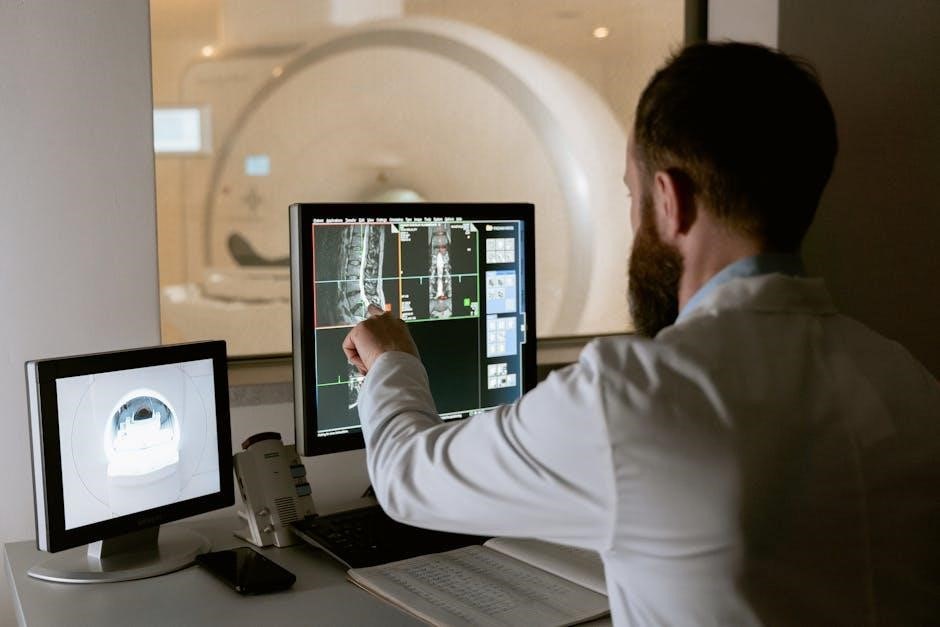Dysarthria is a motor speech disorder affecting communication clarity. Early assessment is crucial for effective intervention, utilizing tools like Frenchay, Newcastle, and Radboud assessments. Speech-language pathologists play a key role in evaluation and treatment planning to improve speech intelligibility and patient outcomes.
What is Dysarthria?
Dysarthria is a motor speech disorder caused by neurological damage or disease, affecting the muscles used for speaking. It results from impaired brain areas, such as the basal ganglia or cerebellum, or issues in motor neurons and speech musculature. Common causes include Parkinson’s disease, stroke, traumatic brain injury, ALS, and multiple sclerosis. Symptoms include slurred, slow, or strained speech, difficulty articulating words, and reduced speech clarity, significantly impacting communication and quality of life.
Types of Dysarthria
Dysarthria is classified into types based on neurological origins. Spastic dysarthria results from upper motor neuron damage, causing strained speech. Flaccid dysarthria, from lower motor neuron damage, leads to weak, breathy speech. Ataxic dysarthria, linked to cerebellar damage, causes irregular speech rhythm. Hypokinetic dysarthria, associated with basal ganglia disorders like Parkinson’s, results in rapid, soft speech. Mixed dysarthria involves multiple neurological impairments, combining symptoms. Each type requires tailored assessment and intervention strategies for effective management.

Purpose and Importance of Dysarthria Assessment
Dysarthria assessment identifies speech impairments, guiding targeted interventions. It enhances communication, improves quality of life, and ensures personalized treatment plans for individuals with motor speech disorders.
Early Diagnosis and Intervention
Early identification of dysarthria through comprehensive assessments ensures timely intervention, minimizing speech degradation. Tools like the Newcastle Dysarthria Assessment Tool and Frenchay Dysarthria Assessment aid in detecting impairments early, allowing speech-language pathologists to implement tailored strategies, enhancing communication outcomes and improving patients’ quality of life significantly.
Guiding Treatment Plans
Dysarthria assessments provide critical insights for designing personalized treatment plans. Tools like the Frenchay and Newcastle assessments evaluate speech subsystems, guiding targeted interventions. Speech-language pathologists use these findings to set clear goals, monitor progress, and adjust therapies. Regular evaluations ensure interventions remain effective, focusing on improving articulation, phonation, and overall communication clarity to enhance patient outcomes and quality of life.

Common Dysarthria Assessment Tools
Common dysarthria assessment tools include the Frenchay Dysarthria Assessment, Newcastle Dysarthria Assessment Tool (NDAT), and Radboud Dysarthria Assessment. These tools evaluate articulation, phonation, and intelligibility to guide treatment.
Frenchay Dysarthria Assessment
The Frenchay Dysarthria Assessment is a comprehensive evaluation tool used to assess motor speech disorders. It includes intelligibility tests at word and sentence levels, evaluating articulation, phonation, and prosody. Speech-language pathologists utilize this tool to identify severity and develop targeted interventions. The assessment provides detailed profiles of speech subsystems, aiding in accurate diagnosis and treatment planning for individuals with dysarthria, ensuring personalized and effective therapeutic strategies.
Newcastle Dysarthria Assessment Tool (NDAT)
The Newcastle Dysarthria Assessment Tool (NDAT) is a detailed evaluation resource for motor speech disorders. It assesses speech subsystems, including respiration, phonation, articulation, and resonance. NDAT provides a structured format for patient information and examiner findings, aiding in the identification of dysarthria severity. This tool supports speech-language pathologists in developing tailored treatment plans, enhancing communication outcomes for individuals with neurological conditions like stroke, TBI, or Parkinson’s disease.
Radboud Dysarthria Assessment
The Radboud Dysarthria Assessment is a comprehensive evaluation tool designed to assess motor speech disorders. It provides detailed insights into speech subsystems, including articulation, phonation, and resonance. This tool aids in diagnosing dysarthria severity and guiding treatment plans. Available for free, it supports speech-language pathologists in improving communication outcomes for individuals with neurological conditions such as ALS, multiple sclerosis, or stroke, ensuring personalized and effective care.

Clinical Examination Process
The clinical examination involves evaluating speech subsystems, such as articulation and phonation, through oral mechanism exams and speech sample analyses. This process informs diagnosis and treatment planning.
Oral Mechanism Examination
An oral mechanism examination evaluates the structure and function of oral-facial muscles. It assesses strength, movement, and coordination of lips, tongue, and palate. This examination identifies structural or functional abnormalities that may contribute to dysarthria. Tools like mirrors or flashlights are used to observe articulation and movement. The process includes tasks such as repeating words, sustaining sounds, and performing specific tongue or lip movements. Findings help guide further assessment and treatment planning for speech difficulties.
Speech Sample Analysis
Speech sample analysis involves evaluating a patient’s speech patterns to identify dysarthria characteristics. This includes assessing articulation, rate, rhythm, and intelligibility. Samples are collected through conversational speech, picture description, or specific tasks like repeating sentences. Speech-language pathologists analyze these samples to determine the severity of speech impairment and its impact on communication. The analysis helps differentiate between types of dysarthria and guides further diagnostic steps, ensuring targeted interventions for improved speech clarity and effectiveness.

Intelligibility Assessment
Intelligibility assessment measures speech clarity, crucial for effective communication. Tools like the Frenchay Intelligibility Test evaluate word and sentence clarity, aiding in tailored dysarthria management plans.
Frenchay Intelligibility Test
The Frenchay Intelligibility Test evaluates speech clarity at word and sentence levels. It assesses how well unfamiliar listeners understand a patient’s speech, providing insights into communication effectiveness. This test is part of the Frenchay Dysarthria Assessment, offering standardized measures to guide treatment and monitor progress over time.
Role of Speech-Language Pathologists
Speech-language pathologists (SLPs) play a central role in dysarthria assessment and management. They conduct comprehensive evaluations, interpret test results, and develop personalized treatment plans. SLPs use tools like the Frenchay, Newcastle, and Radboud assessments to identify specific deficits and track progress, ensuring effective communication strategies and improved patient outcomes through targeted therapy and ongoing support.
Interpretation and Diagnosis
Accurate interpretation of dysarthria assessments helps identify severity and type, guiding targeted interventions. Tools like the Dysarthria Differential Diagnosis Tool aid in pinpointing underlying causes for effective treatment planning.
Dysarthria Differential Diagnosis Tool
The Dysarthria Differential Diagnosis Tool aids in identifying specific types and severity of dysarthria. It involves a comprehensive clinical examination, speech sample analysis, and intelligibility assessments. This tool helps differentiate dysarthria from other speech disorders, ensuring accurate diagnosis. By evaluating speech subsystems like articulation and phonation, it guides targeted interventions. Speech-language pathologists use this tool to develop personalized treatment plans, addressing the underlying neurological or muscular causes of speech impairment effectively.

Role of Speech-Language Pathologists
Speech-language pathologists (SLPs) play a vital role in dysarthria assessment, administering tests, interpreting results, and developing tailored treatment plans to improve communication and speech clarity in individuals with dysarthria.
Conducting Assessments
Speech-language pathologists (SLPs) conduct comprehensive dysarthria assessments using standardized tools like the Frenchay, Newcastle, and Radboud assessments. They evaluate oral mechanisms, speech samples, and intelligibility. SLPs analyze speech subsystems, including respiration, phonation, articulation, and resonance. Assessments may include diadochokinetic rates, maximum phonation time, and intelligibility tests. Their expertise ensures accurate diagnosis and informed treatment planning, addressing communication challenges effectively.
Developing Treatment Plans
Speech-language pathologists (SLPs) create individualized treatment plans addressing dysarthria, focusing on improving speech clarity and communication. Strategies include compensatory techniques, articulation exercises, and breath support training. Goals are tailored to the patient’s needs, incorporating evidence-based methods like Lee Silverman Voice Treatment. Regular monitoring and adjustments ensure progress, enhancing intelligibility and quality of life for individuals with dysarthria.

Future Directions in Dysarthria Assessment
Advancements in automated assessment tools and standardized protocols aim to enhance accuracy and accessibility, ensuring consistent evaluation and improved outcomes for individuals with dysarthria.
Advancements in Assessment Tools
Recent advancements in dysarthria assessment tools include the integration of AI and machine learning for automated speech analysis, enabling more accurate and efficient evaluations. Tools like the Frenchay Dysarthria Assessment and Newcastle Dysarthria Assessment Tool are being enhanced for telehealth applications, improving accessibility. Additionally, wearable technology and real-time feedback systems are emerging, offering personalized and objective measurements. These innovations aim to standardize assessment processes, ensuring consistent and reliable outcomes for clinicians and patients alike.
Need for Standardization
Standardization in dysarthria assessment is essential to ensure consistency across evaluations and improve comparability of results. Current tools vary in methodology, making it challenging to benchmark progress. Establishing universal protocols for assessments like the Frenchay and Newcastle tools can enhance reliability and facilitate data sharing among clinicians. Standardization also supports the development of evidence-based practices, ultimately leading to better treatment outcomes for individuals with dysarthria.